The Windows
- William Morris & Co windows
- East Window
- Illuminated Window
- Martyrs’ Window (West Wall, North Transept)
- Martyrs’ Window (West Wall, South Transept)
- Other Windows
William Morris & Co windows
East Windows (The Lady Chapel)
The East Window
Designed and made by Morris, Marshall, Faulkner & Co., and inserted in the old chancel in 1863 as one complete window, it was refitted by Messrs. Pickett of Leeds for Sir Edward Maufe’s new extension in the early 1960’s.
The glass of the East Window was originally installed as a single seven-light window in Bradford Parish Church in 1863, which in itself replaced an eight-light window inserted in 1671. It was again re-ordered, during the building of the Cathedral extensions 1958-63, this time as three separate windows, a feat involving 30,000 pieces of glass. The glass was originally designed specially for Bradford by William Morris (WM), and his colleagues, Ford Madox Brown (FMB), Edward Burne-Jones (EBJ), Dante Gabriel Rossetti (DGR), Peter Marshall (PPM) and Philip Webb (PW), and was one of their earliest glass commissions
*The image of Saint Mark was previously attributed to Edward Burne-Jones, but has recently been found to be the work of William De Morgan.
These windows may be read in levels from Left to Right, from bottom to top, along with identifying symbols as follows:
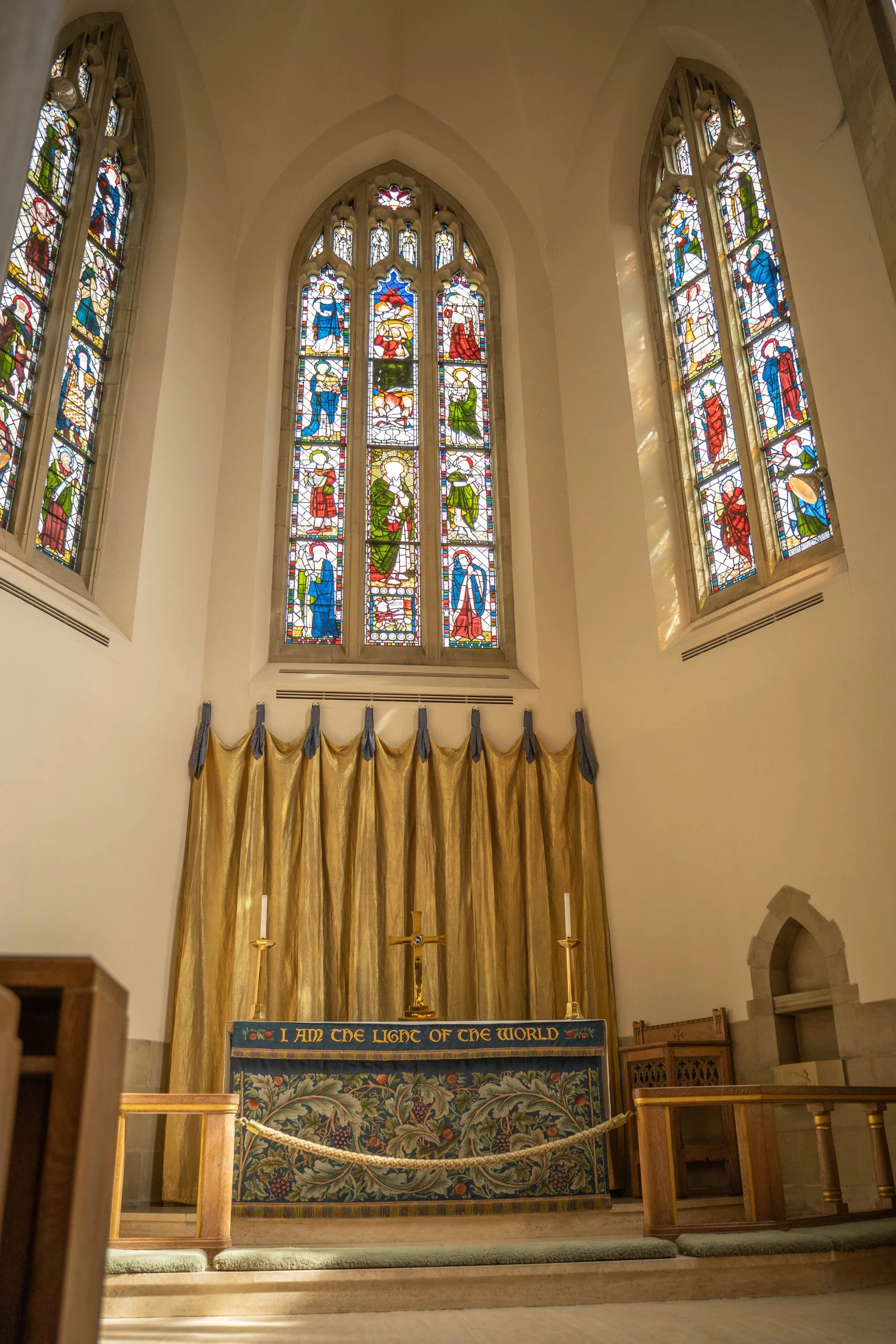
Lowest Tier: Prophets
- Moses Tablets of stone marked 1-X; 2 horns PPM
- Isaiah Scroll: ‘unto us a child is born, unto us a son is given’ WM
- JeremiahScroll ‘Thou wilt return Israel’ WM
- Ezekiel Prayer and hood DGR
- Daniel Mene mene tekel upharsim (Daniel 5:25-28) DGR
- Elijah Raven and bread WM
Second tier: Patriarchs
- Abraham Knife and small son, Isaac FMB
- Old Isaac Blessing and wooden vessel FMB
- Jaco Pan and smoke, pouch DGR
- David Crown, chain mail, no shoes, dove, harp EBJ
- SolomonCrown, blessing and sceptre PPM
- Joseph of Nazareth Bare feet, staff, cloa WM
Third Tier: Evangelists
- John the Baptist WM
- Matthew Winged man, blessing Mark Winged lion and book, scroll WDM
- Luke Winged ox WM
- John Eagle FMB
- Paul Scroll and seal , broad sword FMB
Top Tier: Women
- Anna the Prophetess Stars PPM
- Elisabeth and son
- John the Baptist Stick and cross, berries and leaves FMB
- Virgin Mary Book, Madonna lily, long fair hair, halo EBJ
- Mary Magdalene Long hair, jar of spikenard DGR
- Martha Copper pan, wooden spoon and leather bottle DGR
- Mary of Bethany Long fair hair, book, spray of leaves WM
Centre Panels (from top):
- Christ in Majesty DGR
- St Peter PPM
- Agnus Dei Lamb of God PW
- Tracery:
- Dove descending PW
- Heads WM
- Seraph arms folded WM
- Seraph hands up WM
- Angel with scroll ?EBJ
- Minstrel angel with T shaped dulcimer WM
- Minstrel Angel singing from scroll WM
- Seraph arms folded WM
- Seraph hands up WM
- Archangel Michael WM
- Archangel Raphael WM
- Minstrel angel with T shaped dulcimer ?WM
- Minstrel angel with double pipe WM
- Archangel Uriel WM
- Archangel Gabriel WM
- Pattern work PW
Records show that the first draft of the figure of Mary Magdalene was returned by the Parish Church authorities as being ‘unsuitably clothed’. A second design was deemed more appropriate.
Illuminated Window (North Ambulatory)
This was the central figure in the William Morris Window which originally was inserted in the south wall at the eastern end of what is now the South Ambulatory, but was then part of the old Chancel. The original South Chancel window, from 1864, has been re-sited in three locations: the west walls of the transepts, and the illuminated window in the North Ambulatory. This was originally a perpendicular window of five cinquefoil-headed lights beneath three tiers of tracery.
The central figure of this window, Salvatore Mundi, is by architect Albert Moore. The angels in this window, some playing harps and dulcimers, others holding palms, wreaths and chaplets, were originally fitted into the tracery at the top of the old window, and were designed by William Morris. The Pelican feeding young, was designed by Philip Webb. The glass was refurbished in 1991 by York Glaziers Trust and repositioned in 1992, as a memorial to historian and archivist, Mary Lister.
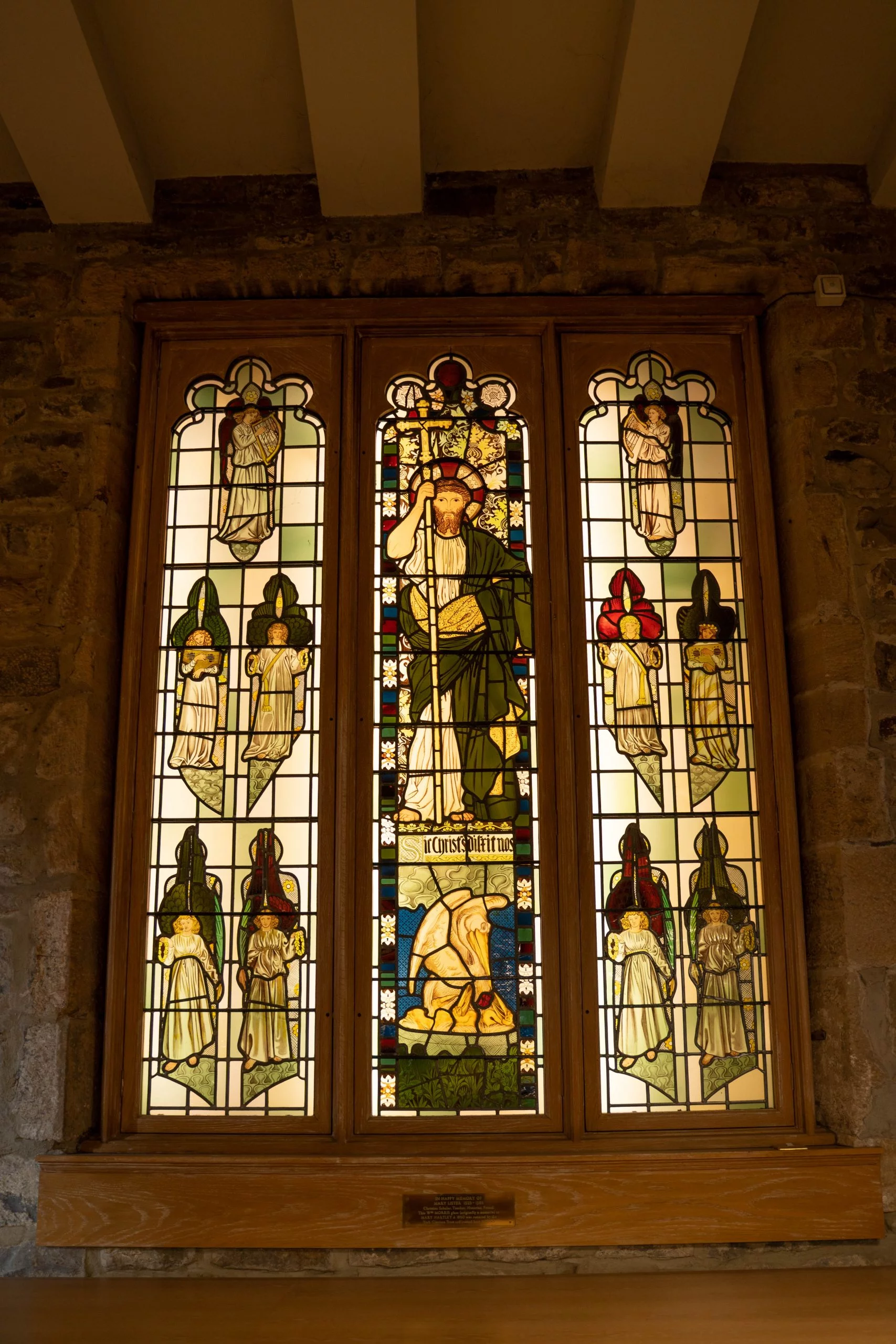
Martyrs’ Window (West Wall – North Transept)
Designed and made by William Morris & Co. 1864
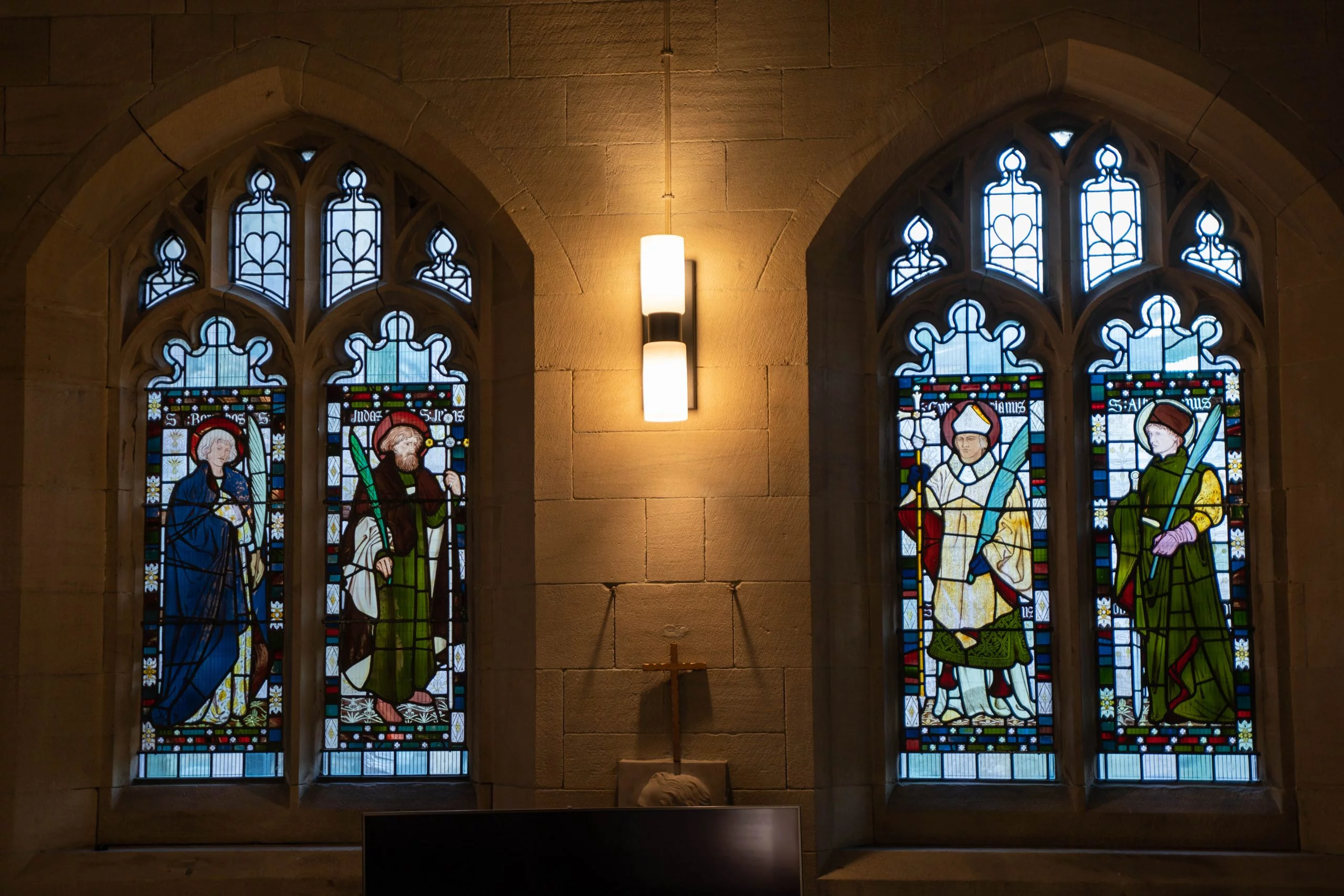
St Barnabas 1st Century
Barnabas was an apostle, and a Jewish Cypriot and Levite.
St Alban 3rd Century
Alban was a soldier and the first known British martyr, linking the Church in Britain with the late Roman Empire.
Originally inserted in the south wall at the eastern end of what is now the South Ambulatory, in 1864. This was part of a much larger window of martyrs and angels surrounding Christ. The rest of the glass is now in the North Ambulatory illuminated window, and the other four martyrs are in the west wall of the South Transept. The old window was dismantled for Sir Edward Maufe’s 1960’s design, refurbished in 1991 by York Glaziers Trust and re-positioned in 1992. The martyrs hold personal symbols and a palm branch which is a symbol of martyrdom.
From Left to Right:
St Barnabas St Jude St Cyprian St Alban
Book Staff In Episcopal dress Sword
Designed by: William Morris Edw Burne-Jones William Morris Edw Burne-Jones
St Jude 1st Century
Jude was an apostle and martyr. He is identified with Thaddaeus.
St Cyprian 200-258
Cyprian was Bishop of Carthage, and a martyr.
Martyrs’ Window (West Wall – South Transept)
St Stephen 1st Century shown with stones Designer: EBJ
Stephen was the first martyr of the infant Christian Church, in Jerusalem. His story is told in Acts chapters 6 and 7. He was one of the seven deacons who were appointed by the Apostles to distribute alms, and he was a gifted preacher. He was stoned for blasphemy and during his execution, had a vision of Jesus at the right hand of God in Heaven. It was at the feet of Saul, that those who were stoning Stephen, laid their robes. Saul (later St Paul) witnessed and consented to, Stephen’s death. His day is 26 December. He is often portrayed holding the martyr’s palm, and stones surround him.
St Andrew (1st Century). Designer: FMB
Andrew was the brother of Simon Peter whom he brought to Jesus. He was martyred for his faith by crucifixion on an X shaped cross.
St James the Great died 44 AD Designed by WM
James the son of Zebedee and brother of John, was a fisherman. He was the first of the apostles to die, being put to the sword at Jerusalem.
St James the Less 1st Century Designer: EBJ
James was the son of Alphaeus, but not a great deal is known about him.
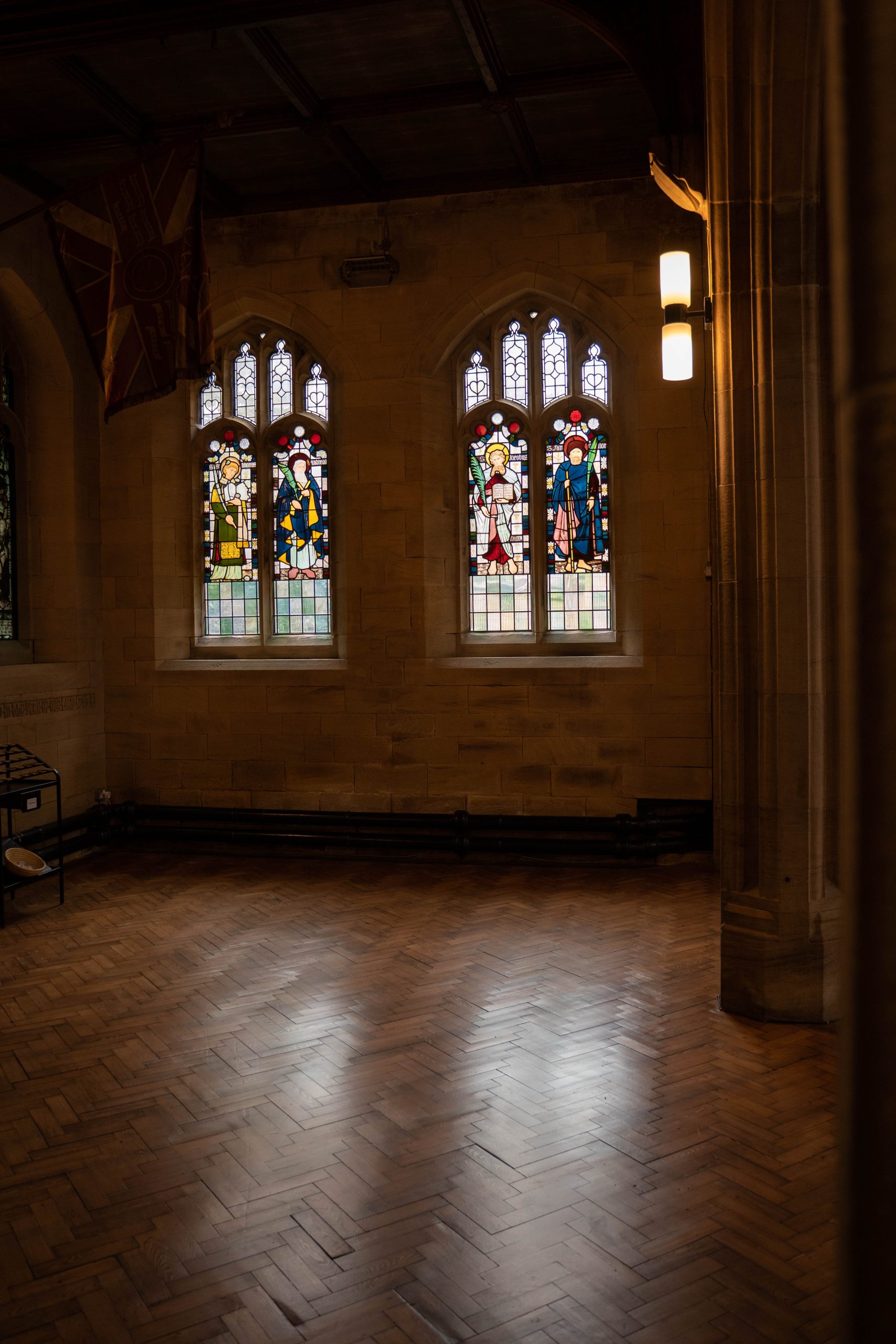
Other windows
The West Window
The Catherine and Jane Wells Memorial Window 1864
Some records show that this window was inserted in 1863 and is the work of Heaton Butler, which became Heaton, Butler and Bayne. The text on the window is partly obscured. The window depicts the theme of Women of the Bible, and was placed here by a Bradford solicitor whose name was ‘Wells’ in memory of his sisters. The main window is divided into five pictures taken from the New Testament – four ‘quarters’ of the window and one central. Above the main window are two rows of small individual figures from Old and New Testaments. The four main quarters are:
Top left: The Angel Gabriel greets the Virgin Mary.
Top Right: Mary Magdalene is greeted by the Risen Christ.
Lower left: Jesus with the sisters, Mary and Martha of Bethany. Martha serves, Mary sits and listens.
Lower right: Jesus speaks with the Woman at the Well.
Centre: The angels tell the women the news that Jesus is risen, on Easter morning.
West Window Top row:
- Symbol for Alpha
- Lily leaves, acorns
- Elisabeth with scroll, John red, green, purple
- Virgin Mary with lily red, white, gold
- Mary of Bethany with jar red and purple
- Martha with cap, plate, keys bronze, blue, red
- Lily leaves, acorns
- Symbol for Omega
- Leaf motifs

Lower row:
- Eve, naked, with cloak Maroon Sarah, elderly, with stick Red, blue, green
- Miriam with musical instrument Red, brown, white
- Hannah with clasped hands Brown, blue, white
- Ruth, back view, carrying brown bag Red, white, pink
- Naomi with white cloth Red, green, gold
- Esther with scroll, crown Red, gold, ermine
- Joanna in prayer Red, green, blue, white
- Anna in prayer Red, gold, turquoise
- Dorcas with tray, loaves, capPink, white, green
Memorial window to the 6th battalion West Yorkshire regiment
Window created by Archibald J. Davis, Bromsgrove 1921
In the top two centre lights of the tracery are St. Michael of Belgium and St George of England. Below there are the shields of Britain, America, Belgium, Japan, Russia and Portugal. On the left-hand light is shown St. Louis the Soldier Saint and King of France, and below the Shield of France. On the extreme left is shown St. Ambrose of Italy and the National Shield. On the right is shown St. Sava of Serbia and the Serbian Shield, and in the extreme right is shown St. Methodius of Romania and the Romanian Shield. These symbolize all the nations who fought with us.
Quick Guide, left panel
- Top lights Aeroplanes, Tudor rose within laurel wreath 49th Division
- Left border Stretcher bearers in front of red cross on white field
- Centre Scene on battlefield ‘Passchendaele’ October 1917
- Right border:Spade in trench
- Left. border Ship riding waves ‘left flank’
Centre Two machine gunners at Lake Nieuport July 1917
- Right border German grenade
- L.eft border Soldier throwing grenade ‘bombers’
- Centre scene of town on fire Thiepval 1916
- Right border Scene of trenches ‘Leipzig redoubt’
- Left.border: Shield of arms of Ypres.
- Centre Town on fire, being bombed.Cathedral on right. Ypres. 1915,16,17.
- Right.border Infantryman holding white flag.
- Left border Shield
- Centre Blue sky with stars – on left a troopship; on right 5 soldiers landing at night. ‘Landed in France 15 April 1915.
- Right border City of Bradford arms. Borders-scenes alternate with sprays of the white rose of York.
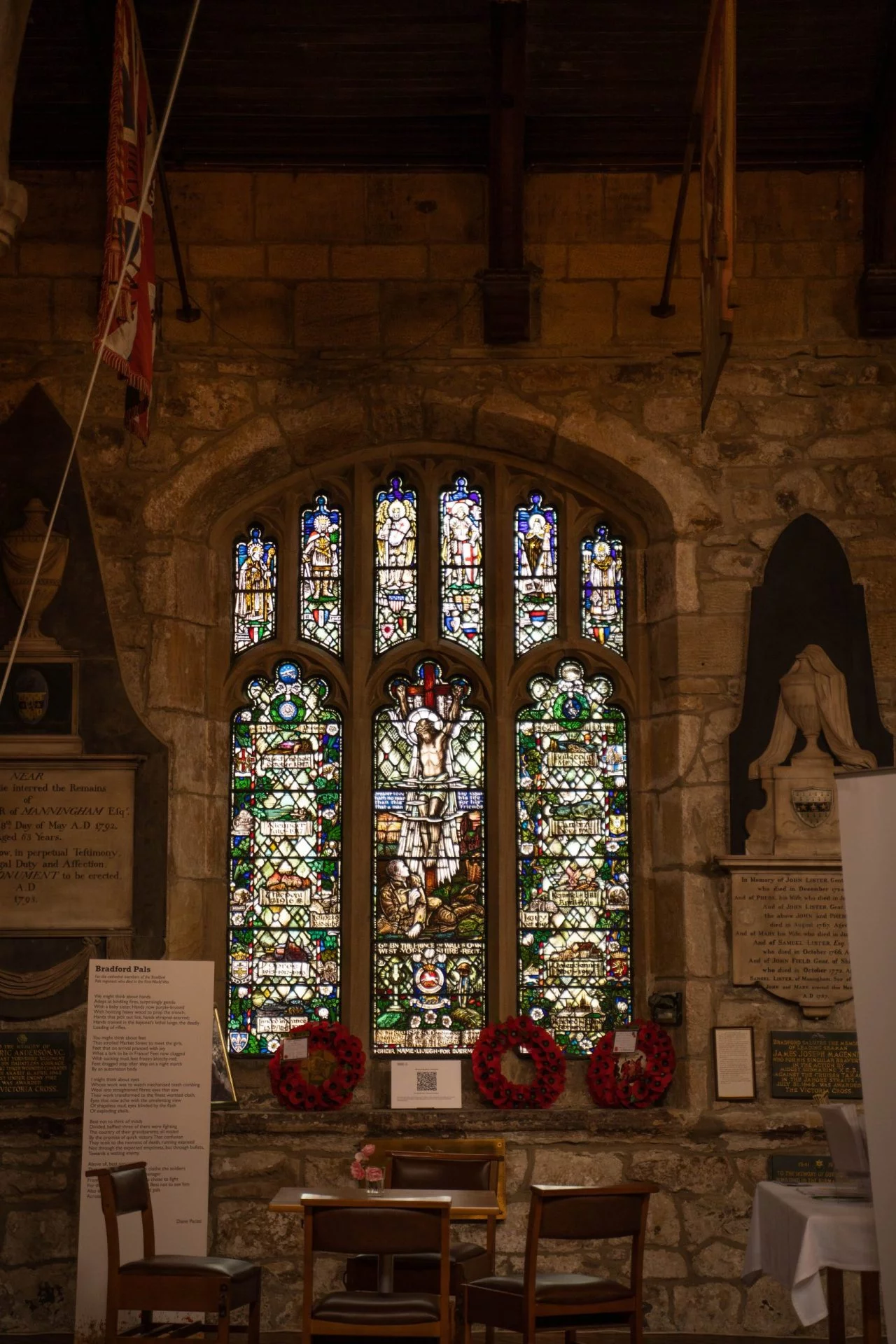
Centre panel
- Jesus on Cross. ‘Greater love hath no man that this, that a man lay down his life for his friends.’ (John 15:13)
- Soldier Khaki uniform of West Yorkshire Regiment.
- Identity disc, rifle, canvas bag.
- Tree, support ropes, church, grave with headstone cross and laurel wreath/poppies.
- Battlefield Rifle, grave with upright rifle and helmet.
- Regimental badge of Prince of Wales Own West Yorkshire Regiment.
Right hand panel
- Top Shellburst, Balloon, Pelican in wreath (There are other tiny pelicans in these windows – a Christian symbol of self-sacrifice. Also around the Cathedral are other pelicans – on the Bishop’s Throne, the Dean’s Stall, in the Holy Spirit Chapel, and on the Font)
- Left border Sprays of the white rose of York
- Centre Battlefield Belle Court May 1917
- Right border Flag. Pack mule. ‘Transport’
- Left border Yorkshire roses
- Centre Tanks – Cambrai November 1917. (First major tank battle in history).
- Right border Arms of Cambrai
- Left border Fieldgun Iway. October 1918.
- Centre Windmills on fire. Kemmel Hill April 1918.
- Right border Two soldiers with wireless. ‘Signallers’.
- Left border Trumpets and drums above a white horse; ‘Famars’.
- Centre Town on fire, shells bursting. ‘Valenciennes Nov.1918’
- Right border Arms of Valenciennes.
- Left border Arms of Diocese of Bradford (formed 1919)
- Centre Town on Rhine with Cathedral – Cologne.
- ‘Reached Rhine February 1919’.
- Right border Yorkshire roses.
Information: A.J.Davies 1921 Bromsgrove.
North Aisle Windows
Lambert and Keeling Memorial Windows, both by the same designer, James Powell & Sons Ltd. The Lambert window was inserted in c.1912 and the Keeling window in 1909.
Lambert Memorial Window (immediate right of North Porch)
This is on the theme of teaching, in memory of Hannah Lambert, teacher.
- Left panel: Phebe (deaconess) and child (Romans 16:1).
- Centre panel: Jesus with Martha and Mary (Luke 10:38-42).
- Right panel: Lois with grandson Timothy (2 Timothy 1:5)
- Note kneeling angel carved on wooden lectern beside child Timothy.
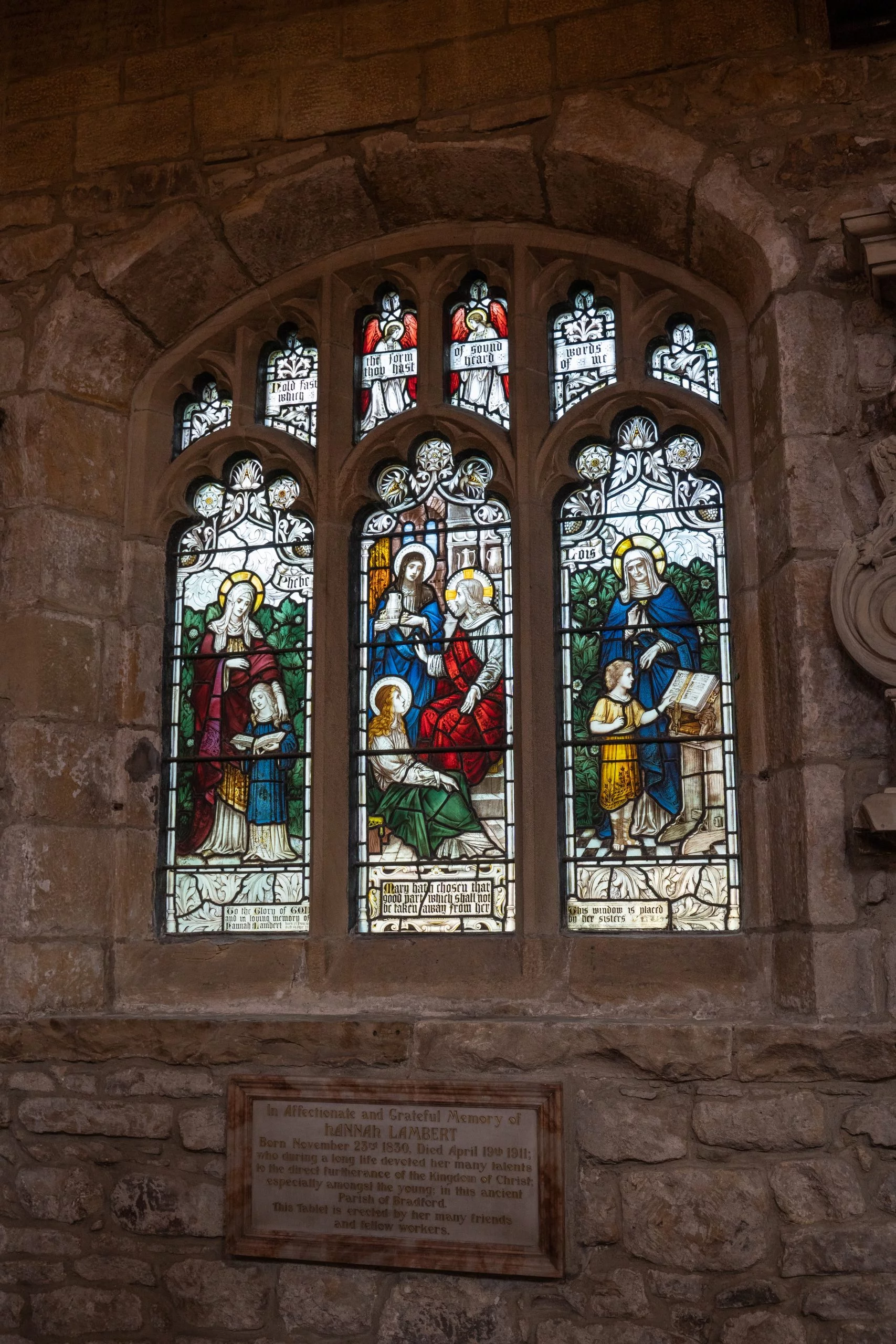
Keeling Memorial Window (far right of North Porch)
This window portrays three women whose name begins with M, shown faintly in the background around each figure.
Left panel: St Margaret of Scotland (with cross).
Centre panel: Virgin Mary and Child.
Note the delicate flower decorations on Mary’s robe, and in the background, some of which are symbolic of her, such as the lily, the rose, and the lily of the valley.
Right panel: St Monica. Died 388. Mother of St. Augustine of Hippo.
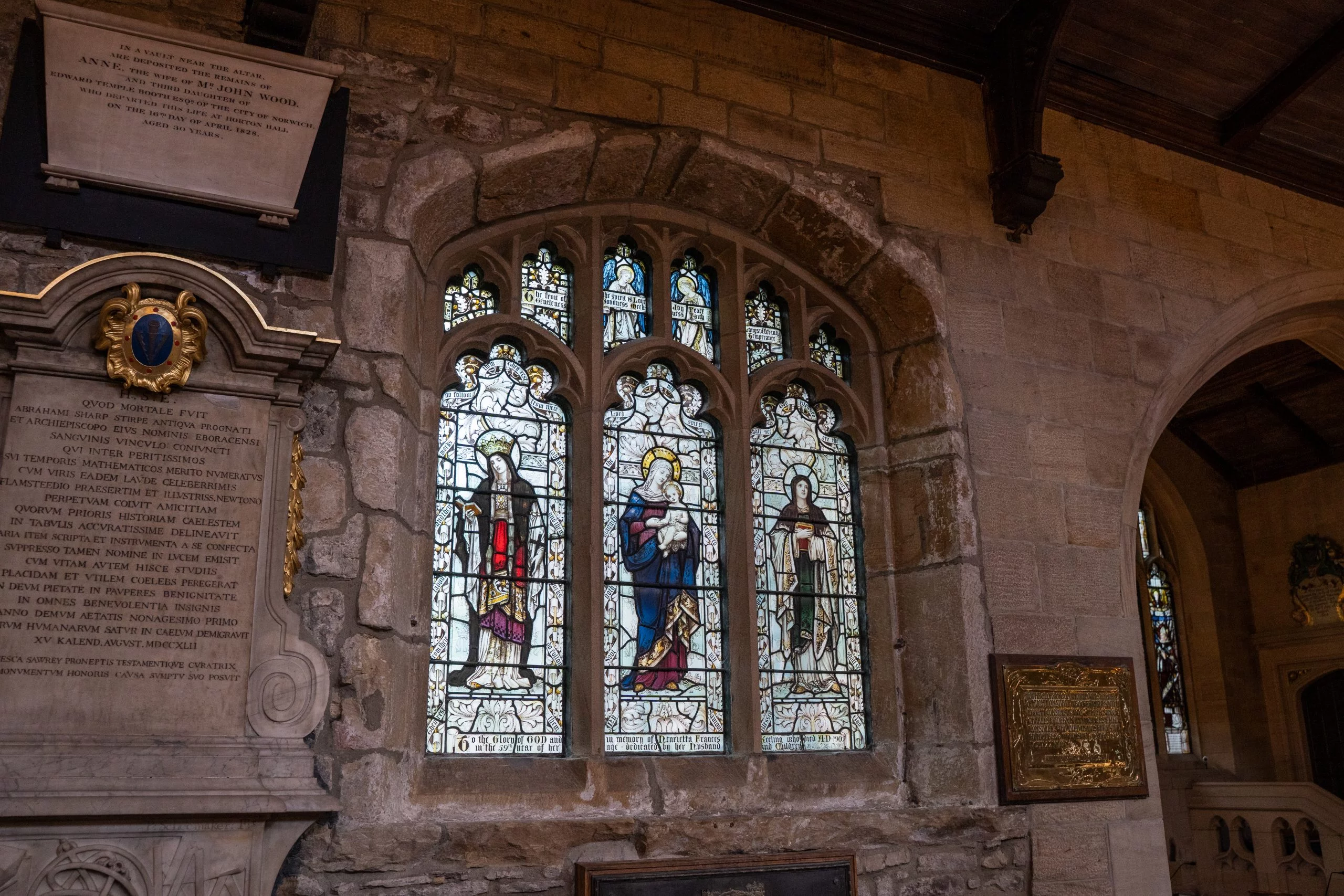
North Transept
North wall: Saints of Northern Britain
These are the Rhodes and Parkinson Memorial windows, both by Shrigley & Hunt, inserted 1898, when the transepts were added to the then Parish Church.
Left hand window
Angels in tracery at top of windows with musical instruments:
- Zither
- Viol (treble)
- Chalmeau (oboe)
- Psaltery
- Dulcimer (knee zither)
- Cymbals
- Psaltery
- Rebec or violin (3 strings)
- Viol
- Shawm
KING EDWIN (585- 633) shown with sceptre and orb
Edwin was King of Northumbria. He married the Christian Princess Ethelburga of Kent.
ALCUIN 735-804 shown with book and pupil
A monk and scholar of York, he became Master of the Palace School of Charles the Great at the Court of Aachen.
THE ARCHANGEL MICHAEL
Shown with armour, sword, lance.
CUTHBERT died 687
Shown carrying King Oswald’s head, and crosier carved with lamb’s head, and wearing mitre and abbot’s robes. Cuthbert, a shepherd boy in the Lammermuir Hills, saw a great light in the sky over the coast, and angels carrying a shining soul to Heaven. He went to Melrose monastery and offered himself as a monk. The vision which began his vocation was of the death of Aidan. He went on to serve in Ripon, Hexham and Lindisfarne, and there created a hermitage in the remote Farne Islands. Bede said of Cuthbert:
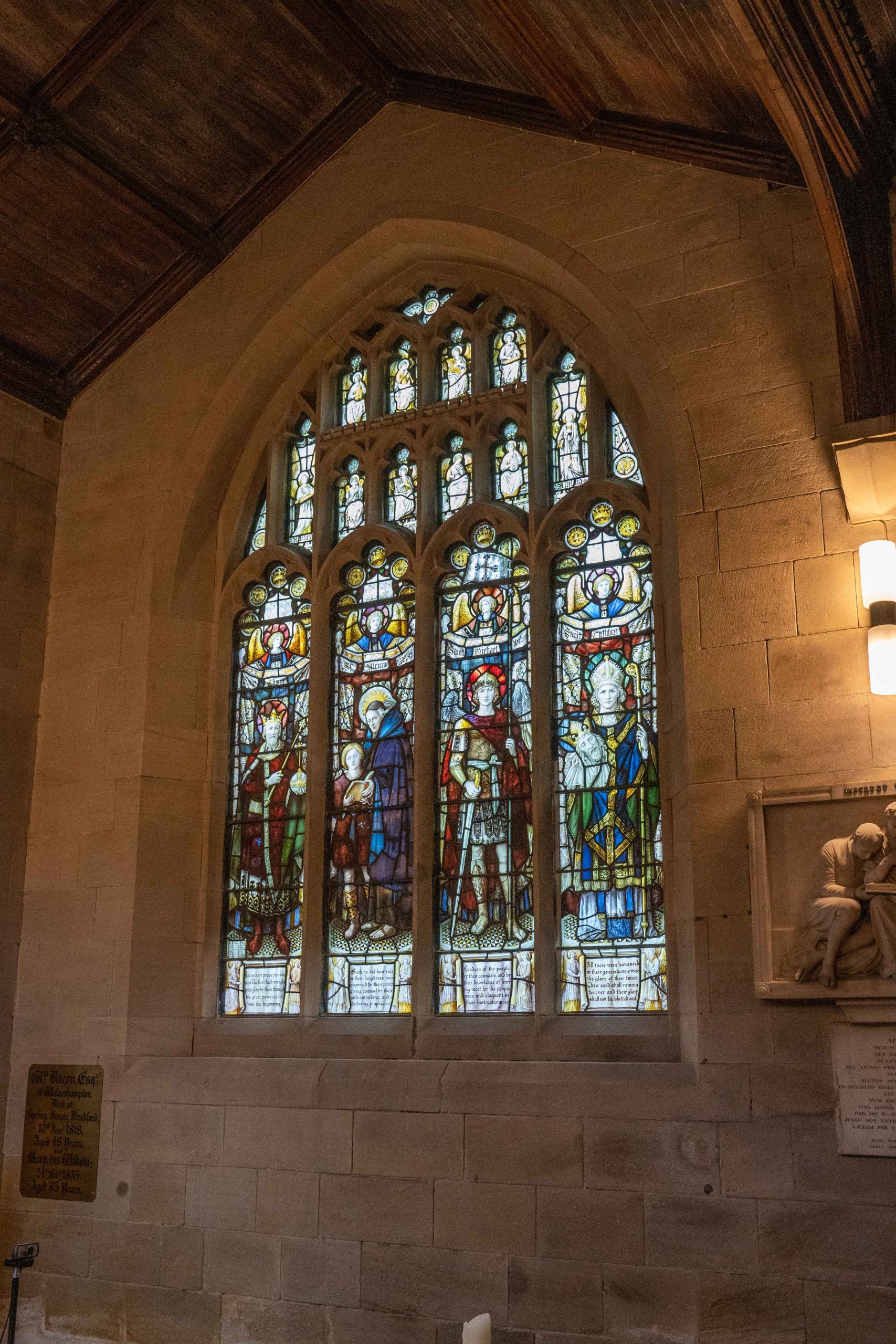
“Above all he was afire with heavenly love, unassumingly patient, devoted to unceasing prayer, and kindly helping all who came to him for comfort. He regarded the labour of help as equivalent to prayer’.
This Celtic monk accepted the Roman tradition at the Synod of Whitby, and his wise bearing had lasting influence on the English Church.
Right Hand Window
Angels in tracery at top of windows:
- Shofar (ram’s horn)
- Zither
- Psaltery
- Harp
- Harp
- Unknown
- Unknown
- Unknown
- Unknown
- Cymbals
COLUMBA 521-597
shown wearing monk’s habit, cowl, belt and pouch, with bare feet and sandals, carrying Celtic crook in Abbot’s position as Abbot of Iona.
Columba was born in Donegal. His mother dreamed an angel gave her a cloak woven with creation’s colours which spread over Ireland to Scotland. Because of a deadly quarrel, he took voluntary exile on Iona, where he founded a monastery, copying Gospels, and carrying out missionary journeys. Adamnan described him as ‘having the face of an angel, polished in speech, sanctified in work, most excellent in disposition, great in counsel, for 34 years an island soldier. He was incessantly occupied day and night, loving to all, always cheerful and holy and gladdened with the joy of the Holy Spirit. His day: 9 June.

AIDAN died 651.
Shown wearing mitre and chasuble and carrying bishop’s crosier and book.
Aidan was an Irish Scot and monk of Iona, who became Bishop of Lindisfarne in the time of King Oswald, his interpreter and companion.
BEDE 673-735.
Shown with tonsure; amice; writing in open book.
This monk and priest became a great scholar who has come to be known as the Father of English History.
WILFRID c.634-709,
in archiepiscopal vestments; with ring and jewelled cross.
A royal Northumbrian, educated at Lindisfarne Wilfrid founded monasteries at Ripon, Stamford, Oundle, Hexham and Selsey.
South Ambulatory
Previously known as the Bolling Chapel
The Mitchell Memorial window was inserted in 1911 or1912. Thought to be created by A K Nicholson, it is the partner of the window in the Listening Room (South East Porch).
ELIZABETH OF HUNGARY 1207-1231, a princess of Hungary. A
HILDA OF WHITBY (614-680). Brought up at the Northumbrian royal court and baptised by Paulinus with her uncle King Edwin, Easter Eve 627 at York.
ETHELBURGA, a Christian princess of Kent, married King Edwin of Northumbria in 625.

South-east Porch
Like its partner in the South Ambulatory, it is thought that this window was created by A K Nicholson and was inserted as a Mitchell Memorial in 1912 or 1913, although there has sometimes been debate as to whether this could be work by Robert Anning Bell. This window depicts the four patron saints of the British Isles – Patrick, George, Andrew and David, with a wealth of detail to explore.
St Patrick 390-461
Patrick, patron saint of Ireland, was probably born in the west of Britain. The window is decorated round the borders with Irish harps, crowns and shamrocks. In the main panel, Patrick is dressed in episcopal robes and is standing on a snake. In the top panel Patrick is seen baptising the daughters of Laioghaire, an Irish King. The shield shows the cross of St Patrick – a red X shaped cross on a white ground.
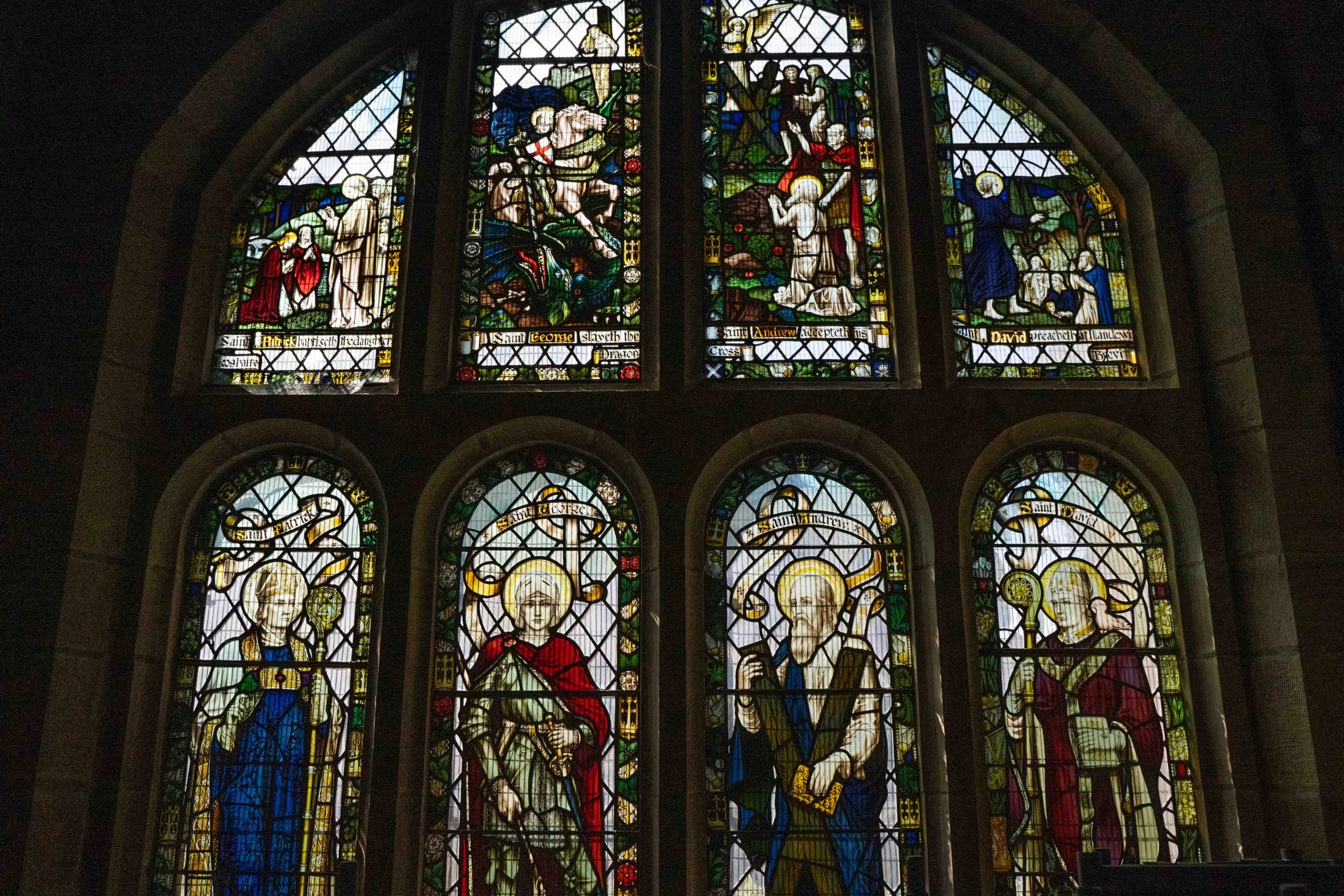
St George died 303
George is said to have been born of a noble Cappadocian family at Lydda in Palestine. The window is bordered by crowns, red and white roses and leaves. George is shown in armor with a banner. The top panel is the legendary slaying of the dragon whilst a captive girl looks on. The shield has the red cross of St George on a white ground.
St Andrew (1st century)
Andrew was the brother of Simon Peter whom he brought to Jesus. The window is bounded by crowns, thistles and leaves. Andrew is shown holding an X shaped cross. In the top panel he is being prepared for crucifixion. The shield shows the Scottish white X on a blue ground.
St David died 601
David, or Dewi, is the patron saint of Wales. The window has Welsh harps, daffodils and leeks in the borders. David is wearing his episcopal robes. In the top panel he is shown preaching in the open air. The shield shows the Welsh Dragon.
South Transept
Also known as the Peace Chapel
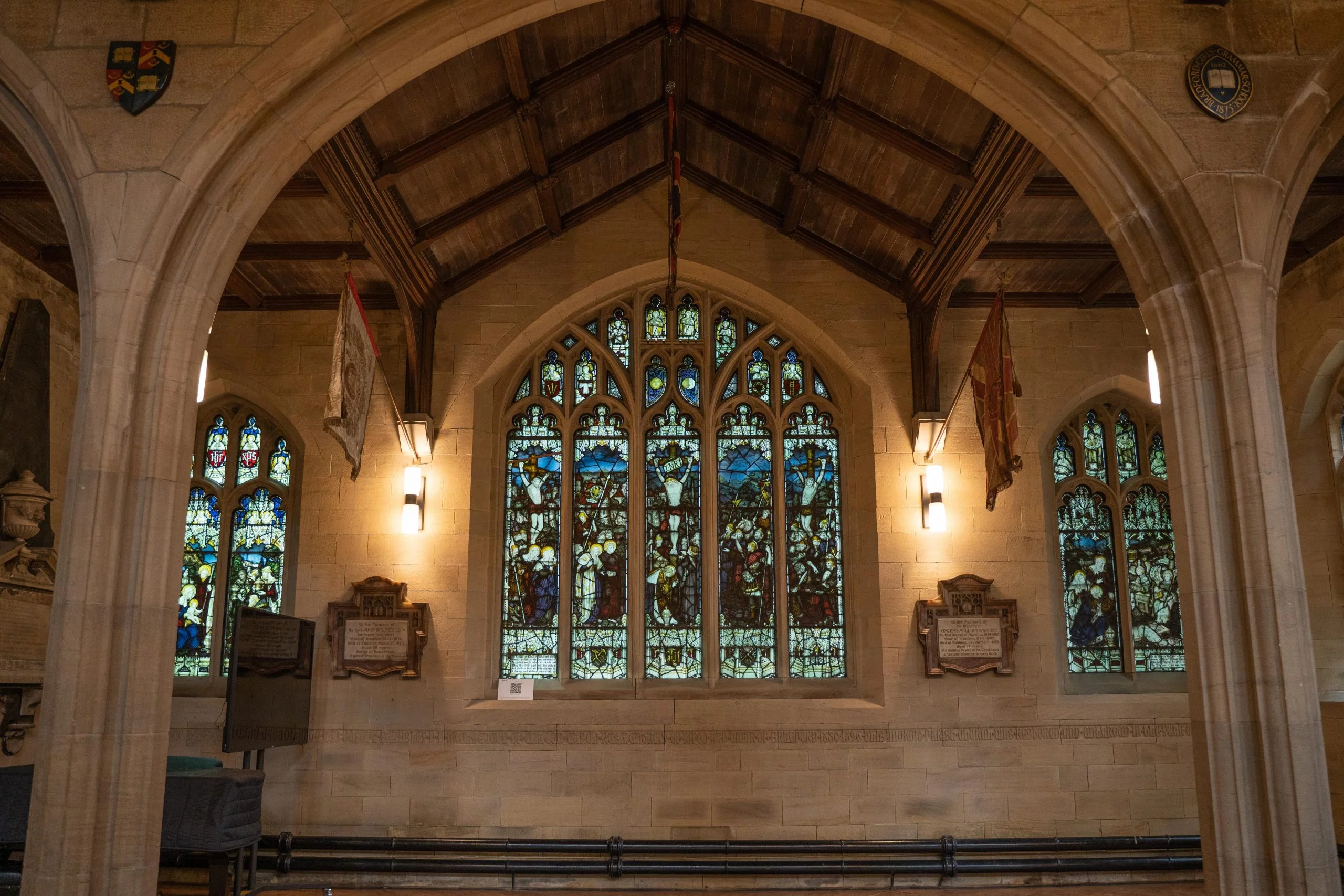
The Epiphany window
Created by Tower & Co. and inserted in 1924 as the Helena Frances Perowne Memorial window for the wife of the first Bishop of Bradford.
In the bottom left hand corner is the Tower trade-mark superimposed on the Kempe wheat sheaf.
The Crucifixion Window
Created by Kempe & Co., and inserted c.1900 for a Memorial to Sir John Cass, died 18 May 1898, aged 65.
Kempe’s wheat sheaf trademark can be seen in the bottom left corner.
The Resurrection window
Created by Kempe & Co, and inserted c.1906 as the Herbert William Maude Memorial window. Maude died 3 Aug 1896, aged 21.
Again, the Kempe trademark can be seen.
Charles Eamer Kempe
Charles Kemp was responsible for two of the tree main windows in the South Transept. The other, the Epiphany window, was made by a relation, Walter Ernest Tower. Kemp was born the fifth son of wealthy parents and educated at Pembroke College, Oxford. He was a deeply religious man, but a serious speech defect ruled out his ambition to enter the Church. He studied under the neo-Gothic architect G F Bodley and became a pupil with the firm of Clayton & Bell. His use of blue, green and ruby glass and large areas of silver staining and delicate and detailed painting of figures are the hallmarks of his style. By the end of the nineteenth century he employed 50 people and completed over 3000 commissions here and abroad, especially in the USA. He uses the wheat sheaf symbol as his trademark, taken from his family’s coat of arms. He died suddenly in 1907 and left the company to his relation, Walter Ernest Tower, who with four of Kempe’s colleagues continued it as a limited company using the wheat sheaf symbol with tower superimposed.
(From: Stained and Decorative Glass by Elizabeth Morris, published 1990)
South Aisle
In these two windows, the figure of Jesus on earth and in heaven, is worshipped by apostles and angels. Scenes from the life and ministry of Jesus are found in the lower, small panels of the left hand window, showing Jesus as teacher, healer and comforter. The south west window portrays the resurrection and its significance.
The Mary Robertson Memorial window
(wife of John Robertson, Vicar in 1896)
Designer not known, possibly 1898
The top lights show angels and two scrolls. The music and words are a setting of ‘For all the saints, who from their labours rest…’ The tune is by a local composer. In the left hand light we see John the Baptist and another kneeling saint, John the Evangelist. The small panels below show Jesus in his earthly ministry. The right hand light shows Mary Magdalene kneeling and Mary the Mother of Jesus standing. The small right hand panel shows the sisters Mary and Martha with Jesus.
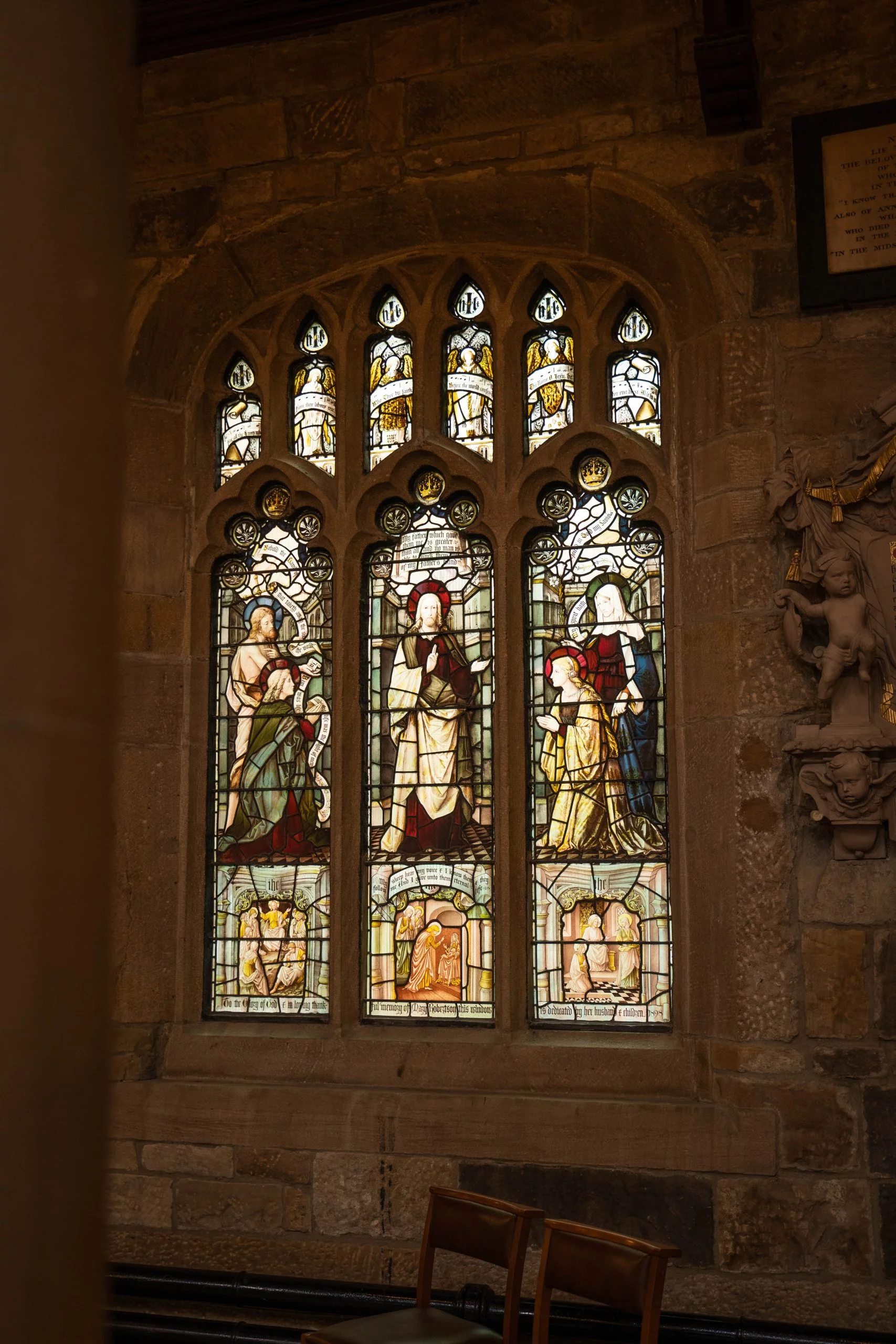
The Richard Fawcett Memorial window
Designer not known, possibly 1898
Richard Fawcett the elder died in 1845 and his son Richard died in 1855. The top lights show four angels and the words ‘Since by man came death, by man came also the Resurrection of the dead.’ The left hand light shows Saint Paul and an angel. The central light shows Jesus crowned and carrying an orb. The small panel below has the text ‘I am he that liveth, and behold, I am alive for evermore.’ The right hand panel shows Saint Peter and an angel with the text, ‘Blessed be the God and Father of our Lord Jesus Christ, which according to his abundant mercy, hath begotten us again, unto a lively hope, by the resurrection of Jesus Christ from the dead.’ The small panel below shows Peter and John at the tomb.
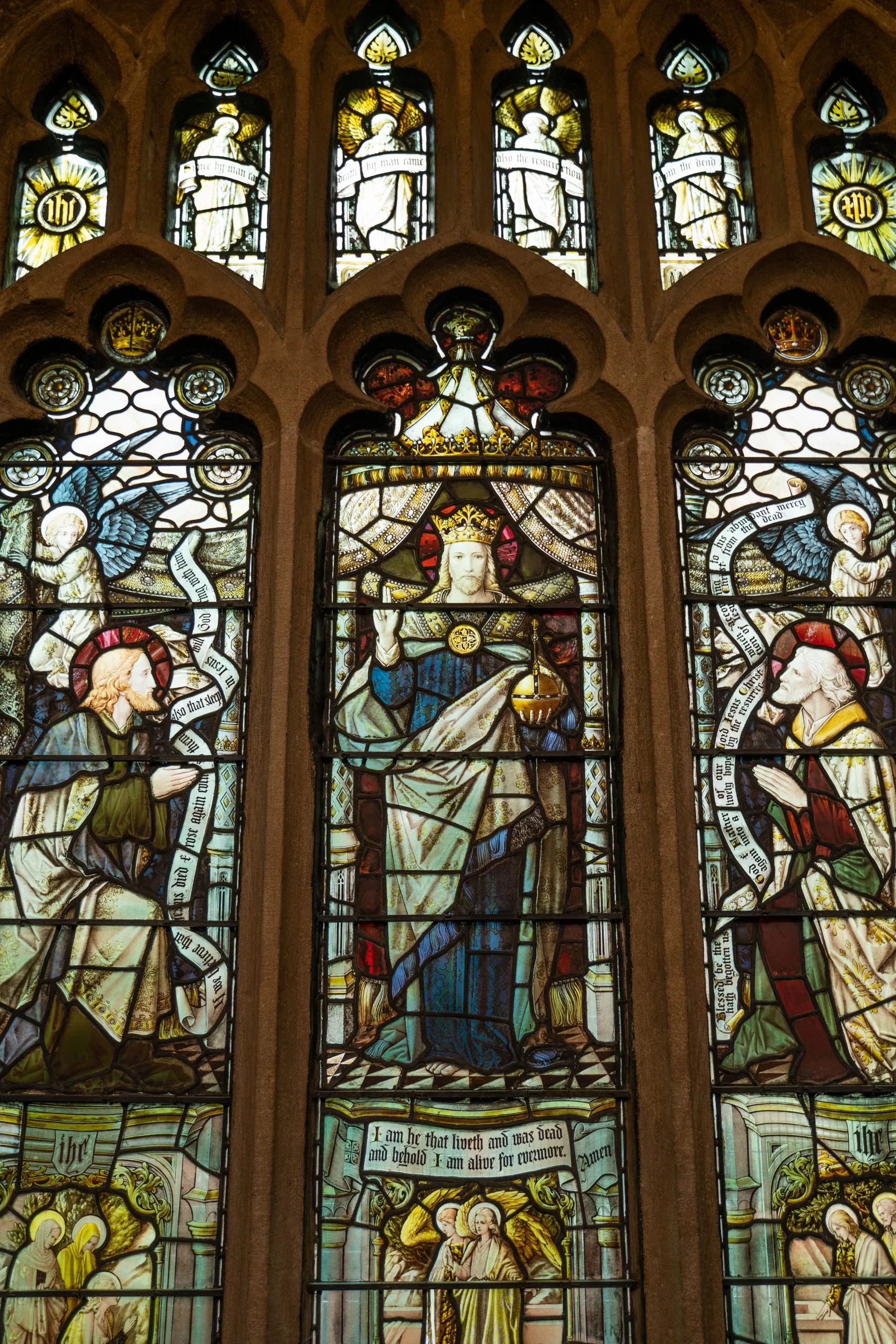
Appendix: A brief history of the West Yorkshire Regiment
(The Prince of Wales’s Own)
Raised in 1685, the Regiment first saw active service in Flanders in 1693. It then served in Ireland and Scotland before going to Gibraltar in 1727 for a 15 year stay. The Regiment returned to Scotland in 1745 until Culloden and returned to Gibraltar in 1751 for another 8 years. In 1759, when stationed at Windsor, it was granted royal permission to wear the White Horse of Hanover. 1776 saw the Regiment in America. This was followed by duty as Marines and then in Jamaica. In 1793, at the Battle of Famars, the Regiment “stole” the march “Ca Ira” from its French adversaries. After this war against the French, the regiment returned home in 1803 and raised a 2nd Battalion, which went to the Peninsular, while the 1st Battalion went to India, and later, the short-lived 3rd Battalion which formed part of Wellington’s Army. After several successful actions in India, the 1st Battalion was, on returning home in 1831, granted the badge of the Royal Tiger, superscribed “India”. After service in the West Indies, Canada and Malta, the Regiment went to the Crimea in 1855 and took part in the capture of Sevastopol. In 1858 the 2nd Battalion was re-formed and sent to New Zealand. In 1876, the Prince of Wales, later Edward VII, presented new Colours to the 1st Battalion at Lucknow and conferred on the Regiment the title “The Prince of Wales’s Own” and in 1881 the 14th was given the title “The West Yorkshire Regiment”. In 1899 the 2nd Battalion went to the South African War where two V.C.’s were awarded.
The 1st Battalion was part of the original Expeditionary Force at the outbreak of the First World War, rapidly followed by the 2nd. The Regiment grew to 37 battalions, including Territorials, of which 24 saw action overseas and received many decorations. Among these was the French Croix de Guerre, awarded to the 8th (Leeds Rifles) Battalion for gallantry in the capture of Bligny Ridge. The Roll of Honour, including over 13,000 names, may be seen in the Regimental Chapel in York Minster. With a return to peace in 1918, the Regiment was reduced to two Regular and four Territorial Battalions. The 1st Battalion spent much of the Second World War in Burma, while the 2nd Battalion served in Egypt, Cyprus and Tobruk before going to India and Burma, finally returning to UK in 1948 when it amalgamated with the 1st. This Battalion took part in the Suez operation in 1956 and was then stationed in Dover until amalgamation in 1958.
